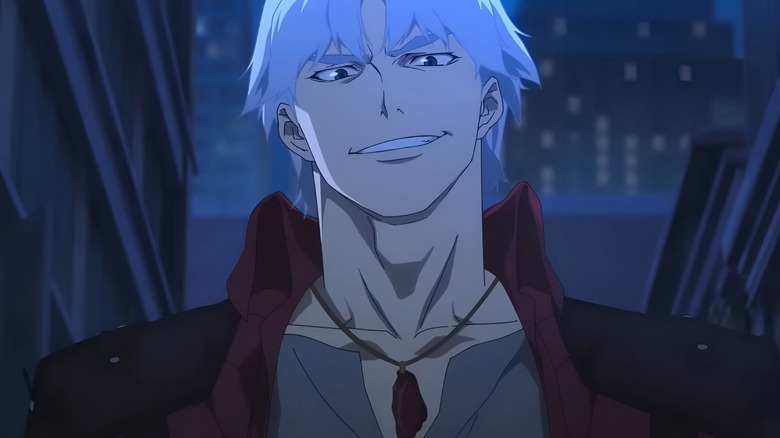The Perfect Amulet In Netflix's Devil May Cry, Explained
Adi Shankar's "Devil May Cry" is a labor of love, a passionate reinvention of the eponymous video game franchise that is known (and loved) for its signature eccentricity. Speed and agility are at the core of any "DMC" gameplay, combined with highly-stylistic combat flourishes that can lead up to insane chain attacks and combos. Beneath these slick, over-the-top sensibilities (which have gifted the community with wondrous memes) lies dense, sprawling lore about demonic rebellions, primordial guardian swords, and the most complex, trauma-infused sibling relationship known to man.
While Netflix's "Devil May Cry" leans confidently towards the franchise's effortlessly cool aesthetics, it also brings the best parts of the often confusing video game lore to life. There are plenty of pleasant surprises here, as Shankar repackages familiar threads into something wholly different. For example, White Rabbit (Hoon Lee) — featured only in the "Devil May Cry 3" manga — is presented as the unexpected antagonist here, but this creative swing works exceptionally well with regard to the central story. Well, some things never change: a young Dante (Johnny Yong Bosch) is as cocky and competent as ever, using his penchant for theatrics and awkward humor to mask the deep-seated trauma associated with his past. However, series-only additions like Darkcom (a morally gray superstructure in a world torn apart by conflicting motivations) introduce enough diversions from the source material to stand on their own merit.
Dante's story is inexplicably tied to his brother, Vergil (Robbie Daymond), especially in terms of their shared heritage as the sons of the legendary dark knight, Sparda. Although Sparda's in-game lore is incredibly convoluted, the Netflix adaptation simplifies this branch of the story by focusing on a singular object: the Perfect Amulet. How does Shankar's show (which echoes the ingenuity of Netflix's video game-based "Castlevania" series) leverage this artifact in its favor, and how does it measure up to its role in the games? Let's dive into it.
The Perfect Amulet is more than a MacGuffin in Netflix's Devil May Cry
Core tenets of Dante and Vergil's origins are kept intact in the series, as much of their childhood lore evolves beat-by-beat to drive home the seed of pain and conflict that gets sewn due to fate and circumstance. Dante assumes that Vergil is dead for most of the series and is shocked to learn about his demonic hybridity, especially the fact that he is Sparda's son. Dante's intense emotions circle around his inability to protect his mother, which explains why he is so adamant to protect his half of the amulet. This necklace is the only tangible memory of her, along with that of a life that used to be gentle and devoid of pain, where he was surrounded by people he loved. Of course, there's more to this amulet, as it is also the embodiment of his bond with Vergil; the brothers are two halves of a whole despite walking distinctly different paths.
The primary function of the Perfect Amulet is essentially the same as in the games (with some minor alterations). Dante's half of the amulet (red), when combined with Vergil's half (blue), forms an ornate amulet that is the key to the Temen-ni-gru's gate to the Demon World. As the series allows White Rabbit to assume control of the Force Edge, he has access to all parts of the puzzle to wreak havoc upon Earth, save for the blood of Sparda's sons, which is necessary to activate the portal. Much of the animated series devotes itself to unraveling its function, as Dante's half of the amulet is a coveted artifact for the big bad, who already has Vergil's half on his person. The stakes hinge on Dante's ability to combat demons while saving innocent lives, as his hybrid nature makes it imperative that he keep his darkest impulses in check.
Although the Perfect Amulet is technically a part of a key to unlock a heavily fortified Hell Gate, the Netflix series cleverly uses it to flesh out character motivations in the foreground. For instance, Mary/Lady (Scout Taylor-Compton) is in blind pursuit of Dante's amulet because she's following orders, but this journey opens her eyes to the fact that not all demons are inherently violent or destructive. Considering her traumatic past, this eye-opening revelation allows her to readjust her priorities and align herself with Dante in his quest to get back what's rightfully his.
How the Devil May Cry games use the Perfect Amulet to enrich its central dynamic
Let's talk about "Devil May Cry 3: Dante's Awakening," my absolute favorite entry in the video game series (I swear this is relevant). The events of the game are set almost a decade before that of the original "Devil May Cry" and follow a young Dante, who is targeted by Vergil for his half of the amulet. Vergil's motivations are never simple to parse, which is why his intention to open a portal to the Demon World is more nuanced than it seems, prompting Dante to try and stop his brother from making such a grave mistake. However, Vergil's (unfounded) disdain toward Dante fuels his obsession, leading to his victory atop the Temen-ni-gru after a tense battle with his brother. Now armed with both pieces, Vergil creates the Perfect Amulet and activates the tower but is soon blindsided by unexpected betrayal.
"Dante's Awakening" is a relentlessly thrilling "DMC" installment, thanks to multiple combat modes that are unlocked as the game progresses. This perk achieves peak potential during Dante and Vergil's fight against Arkham, who plans to use the Perfect Amulet to activate Force Edge, intending to wield its power and rule over a demon-infested Earth. Long story short: Mary is also a part of Arkham's pursuit, but Dante reaches him first, and the two battle intensely until Vergil joins in to level the playing field. After the brothers work together to expel Arkham from the Demon World, Mary finds her father and kills him before renouncing her birth name. As for the fate of the Perfect Amulet, Dante and Vergil battle it out (as usual) to claim their respective halves, parting ways temporarily after departing with their necklaces.
Fast-forward to the timeline of 2001's "Devil May Cry," Dante's half of the amulet plays an integral part in fleshing out Vergil's arc, who has now lost his memories and goes by Nelo Angelo. The other half of the amulet triggers a visceral emotional reaction in Vergil, underlining the unshakable bond with his brother despite their complicated relationship. As you can probably guess, the halves do end up reuniting to defeat a greater evil, continuing the saga of Sparda's sons putting aside their differences and banding together when the world(s) need them the most.


